INTRODUCTION
The Climate Change is a very abstract, large and remote phenomenon with 50 to 100 year horizon what makes it difficult to act on it with any sense of urgency. In many climate zones, the Urban Heat Island (UHI) is a more immediate, local and palpable challenge, with a 5 to 10 year horizon. Strategies to mitigate and adapt to the Urban Heat Island Effect are almost identical to the challenge of global climate change.
In a sense the UHI can be invoked as an effective motivator and mobilizers of behavioural and physical change in many climate zones of the world. Direct interventions tend to have quicker and more tangible results, so they are typically more satisfying and motivating.
The UHI brings increasingly uncomfortable air temperatures in cities and thereby diminish their appeal. People are likely more encouraged to migrate to suburban and rural areas. This migration of urban residents - with their life styles - to the of suburban an rural areas, will be -in equivalent- more wasteful, energy-consumptive and carbon-intensive.
WHAT IS THE URBAN HEAT ISLAND?
UHI can be conflated and confused with global CC. There is considerable overlap, but also consequential difference. UHI is a local phenomenon. And the increase of local is not from GHGs trapping heat in the atmosphere, but from a local increase in sensible heat.
Sensible heat comes from two sources
- hot gases emitted from tailpipes and chimneys,
- heat from dark surfaces - blackish rooftops, streets and parking lots - that have been heated by the sun to temperatures hotter than the surrounding air and surfaces.
Both heat sources raise the average urban temperature higher than the surrounding suburbs and rural countryside or wilderness
The rural to urban temperature gradient can be 4 to 6 or more degrees Celsius. During heat waves temperature differences between city center(s) and countryside may double.
- Higher temperatures amplified the UHI effect and make outdoor activities too uncomfortable for most people.
- Heat waves most large cities are trending hotter and more frequent and become more humid.
- Citizens in hot, already humid tropical zones already experience the sickly and deadly combination of high temperatures and high humidity.
- Because of global warming the all over water vapour context of the atmosphere raises and thus humidity.
- There is an increasing need for more air-conditioned cool centres, resulting in more emitted heat and greenhouse gasses.
CONSIDERATIONS
Why is it desirable for more people to live in cities? Compared to their suburban and rural counterparts, urban residents have smaller energy, carbon and ecological footprints, which is the equivalent area needed to provide the resources they consume and to absorb their wastes.
URBAN HEAT ISLAND (UHI) MITIGATION AND ADAPTATION STRATEGIES
Primarily there are three ways to mitigate and adapt to UHI in order to achieve urban cooling.
1. Albedo Enhancement (lighter-coloured roofs and pavement)
2. Sensible Heat Reduction (hot gases from tailpipes and chimneys)
3. Cool Micro-climates (trees and vegetation to shade, filter, cool the air, etc., while providing scale, beauty and other amenities)
On top of their urban cooling benefits, all three of these Lean strategies are proven antidotes to global Climate Change (CC). They directly adapt to CC by tempering increasing global air temperatures and simultaneously and indirectly helping with mitigating these increases. They are achievable, easily understandable strategies that lend themselves to distributed, by democratic action at the local scale.
ALBEDO ENHANCEMENT SIMPLIFIED
More reflective surfaces, especially horizontal ones like roofs and pavement, are very effective ways to bounce back solar radiation before it heats up the surface and nearby air.
Albedo is measured by the Solar Reflectivity Index (SRI). The SRI indicates the percentage of solar radiation that is bounced back through the earth’s atmosphere into outer space before it heats up any mass or air.
- Solar energy that hits dark coloured surfaces makes a photo-thermal conversion. This photo thermal conversion changes short wave solar energy in to longer wave infrared radiant heat, which in turn is be trapped by the earth’s atmosphere.
- Solar energy that hits light coloured surfaces is reflected back into space before it makes a photo-thermal conversion. The solar energy enters, is reflected and leaves our planet without heating it up.
White and light coloured horizontal surfaces with a high SRI – primarily roofs and pavement–
- increase the urban albedo,
- reducing the ambient air temperature.
- Converting half a city’s rooftops to with roofs or green roofs,
- It is estimated that urban temperatures can be diminished up to 3 degrees Celcius by converting half a city’s rooftops
SENSIBLE HEAT REDUCTION SIMPLIFIED
Reduce the local production and release of sensible heat into the urban environment, in the form of hot air and other gases. This means decreasing the combustion of hydrocarbon fuels in both motor vehicles, power plants and industrial processes.
- The most significant sources of UHI are vehicle traffic.
A effective way to reduce tailpipe emissions of heat is a better organized and facilitated public transport system that foresees in the need of urban transit.
- A emerging problem would be the energy demand due to the increasingly ability to afford energy-intensive mechanical systems. Processing voluminous amounts of hot humid air in cold air by means of air conditioning systems.
CREATING COOL MICRO-CLIMATES
This cooling is achieved primarily with plant materials, especially shade trees.
Trees along streets, roads and in parking lots constitute a large and particularly effective urban tree canopy.
The list of the environmental contributions of vegetation is long: trees provide cool shade, evaporation-transpiration that cools and moistens the air, particulate pollution filtration, soil retention, water retention, while absorbing sound and shaping public space.
UNSOLVED QUESTIONS
The direct and indirect relationship between UHI and CC is very complex and not fully understood yet. The interaction between the Urban Heat Island’s micro climate with that of the surrounding suburbs an rural areas. Complicating factors on determination of the air temperature would be te interaction between albedo-increasing cloud covers and surface cooling rains. And many other parameters.
.














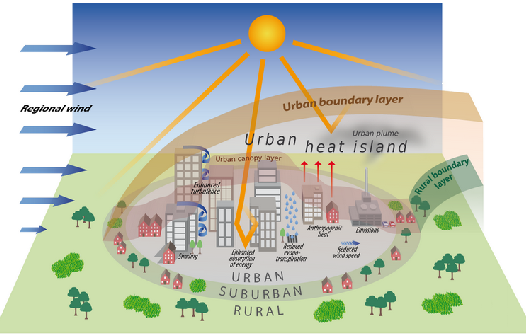
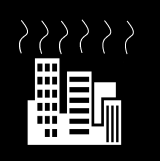
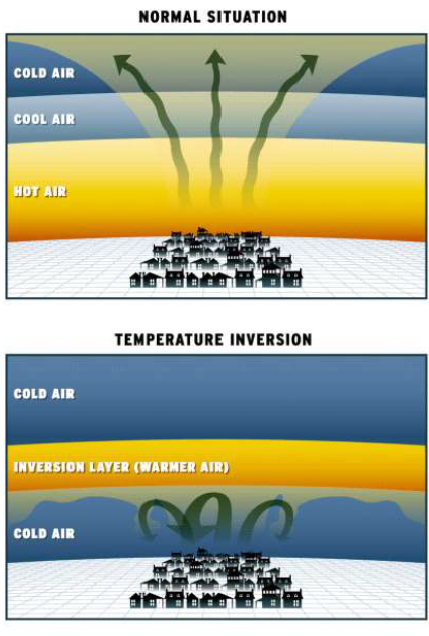
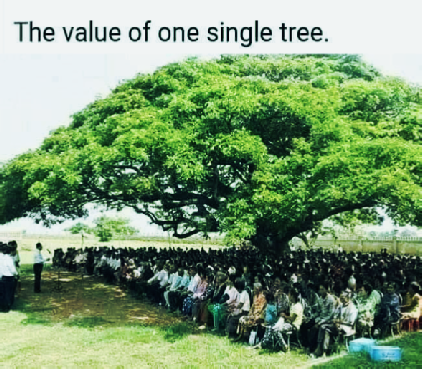
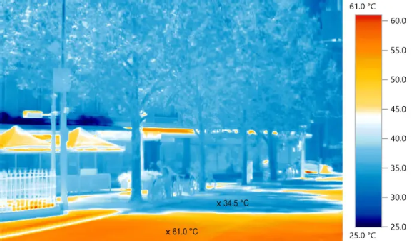
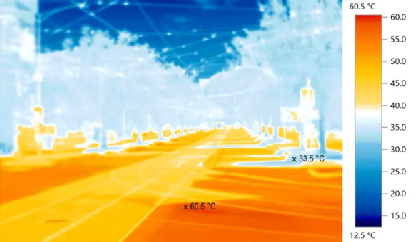
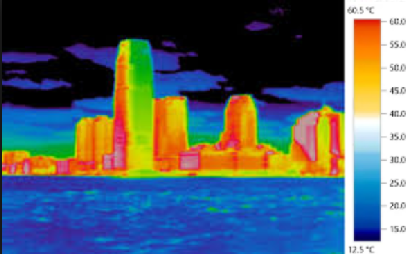


 THE
THE AIR POLLUTION
AIR POLLUTION